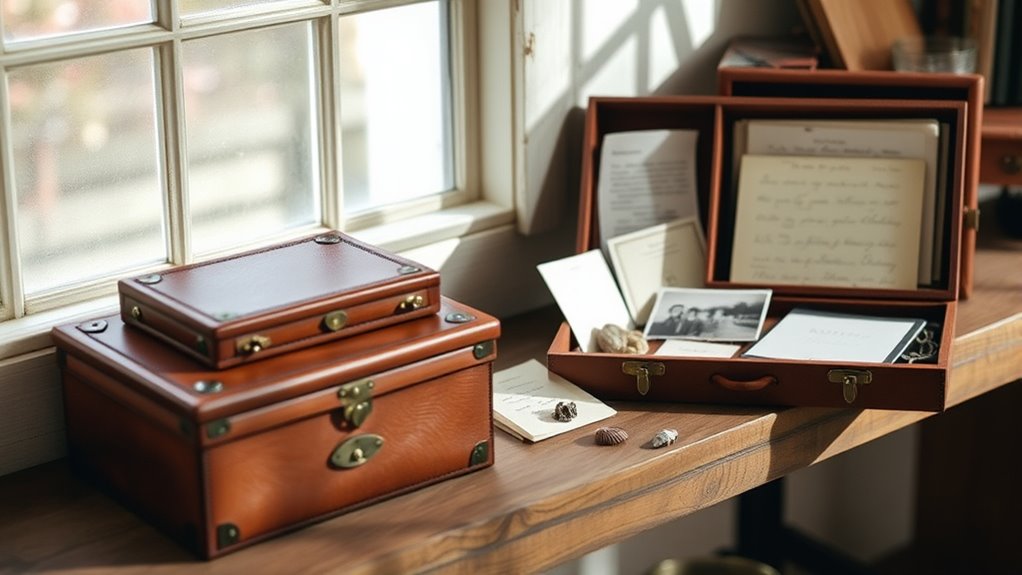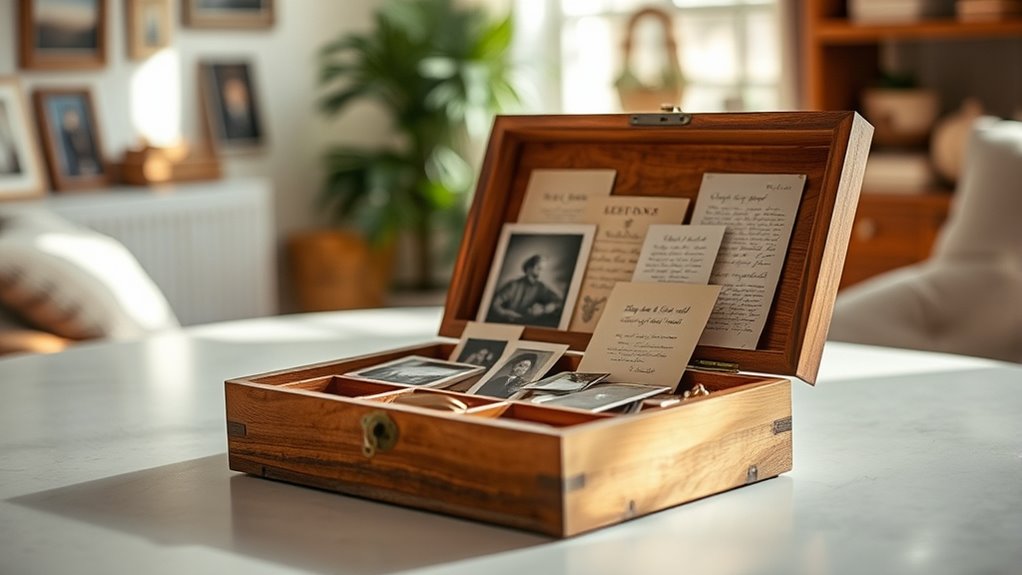To cherish your memories without clutter, focus on selecting only meaningful items that tell a story and evoke strong emotions. Use a sturdy container with labeled sections for different keepsakes, and preserve photos in acid-free sleeves or digital backups. Regularly review your collection, removing items that no longer hold significance. Prioritize quality over quantity, ensuring each piece adds value. Keep your memory box organized and manageable—if you want to learn more about doing it right, you’re in the right place.
Key Takeaways
- Select only meaningful, emotionally significant items that tell a story, avoiding unnecessary clutter.
- Use organized storage with labels and dividers to keep items accessible and well-preserved.
- Prioritize quality over quantity by regularly reviewing and updating your collection.
- Preserve items through proper methods like acid-free sleeves and digital backups to ensure longevity.
- Maintain a clutter-free collection by periodically removing items that no longer hold strong sentimental value.

Creating a memory box is a meaningful way to preserve your most cherished moments, but doing it right guarantees these keepsakes remain meaningful for years to come. When you carefully curate what goes into your box, you ensure that each item tells a story and holds true sentimental value. The key is to avoid filling it with clutter that dilutes its significance. Instead, focus on selecting only the most meaningful pieces—photos, letters, small mementos—that truly reflect important moments in your life.
Start by setting clear criteria for what belongs in your memory box. Ask yourself if each item sparks joy or holds a special story. If it doesn’t, consider letting it go or storing it elsewhere. Your goal is to keep only those items that evoke strong memories or emotions. This process helps prevent overwhelm and keeps your box manageable. Remember, less is more; a well-curated collection will be more powerful than a cluttered jumble of miscellaneous objects.
Organization is vital to maintaining your memory box’s integrity. Find a sturdy container that protects your keepsakes from damage. Label sections or use dividers if needed, so you can easily locate items later. For example, you might have a section for childhood memorabilia, another for travel souvenirs, and a corner for handwritten notes or cards. Proper organization guarantees that your treasured items stay in good condition and are easy to enjoy whenever you open your box.
Be selective about the condition of your items. Preserve photographs in acid-free sleeves, and avoid keeping fragile objects that might deteriorate over time. For paper items, store them flat and in a cool, dry place to prevent fading or mold. If you want to include digital memorabilia, consider creating a digital backup or scan of the items. This way, you’ll have a lasting record without risking damage to the original.
Additionally, understanding the importance of pollution and how it impacts our environment can deepen your appreciation for preserving meaningful items in an eco-conscious way. Finally, review your memory box periodically. As your life evolves, you might find new treasures to add or decide to retire some items that no longer hold the same significance. Keep it a living collection that reflects your current self, but always prioritize quality over quantity. By doing so, you guarantee your memory box remains a meaningful, clutter-free reflection of your most treasured life moments for years to come.
Frequently Asked Questions
How Often Should I Update My Memory Box?
You should update your memory box whenever you have new meaningful items or experiences to add, typically every few months or after significant milestones. Regular updates keep your box current without becoming overwhelming. Avoid overstuffing it; instead, choose quality keepsakes that truly matter. Set a reminder to review and add to your box periodically, ensuring it remains a cherished collection of memories rather than clutter.
What Materials Are Best for Preserving Keepsakes?
You should use acid-free materials, like archival-quality boxes, tissue paper, and sleeves, to preserve keepsakes effectively. These prevent deterioration and fading over time. Avoid plastic with PVC or other non-archival plastics, as they can damage your items. Use soft, acid-free tissue for wrapping delicate objects, and store items flat when possible. This careful approach keeps your memories safe and vibrant for years to come.
Are Digital Memory Boxes a Good Alternative?
Did you know that over 70% of people prefer digital memory boxes for their convenience? Digital memory boxes are a great alternative, offering easy access and space-saving benefits. They let you organize photos, videos, and documents effortlessly, ensuring your keepsakes are preserved without physical clutter. Plus, digital backups protect your memories from damage or loss, making them a practical and modern way to cherish your most precious moments.
How Do I Involve Children in Creating Memory Boxes?
You involve children in creating memory boxes by making it a fun, collaborative activity. Let them choose special items like artwork, photos, or small mementos that mean something to them. Encourage their creativity by decorating the box together and sharing stories behind each item. Ask questions to help them express their feelings and memories. This way, they feel connected and proud of their personalized keepsake.
What Is the Ideal Size for a Memory Box?
Think of the perfect memory box as a cozy treasure chest—about the size of a shoebox or small storage bin. It’s large enough to hold meaningful keepsakes but small enough to avoid becoming a cluttered mountain. You should be able to access and enjoy the contents easily, yet it remains manageable. Find a size that fits your space and your heart’s collection, creating a beautiful, organized keepsake.
Conclusion
By creating memory boxes that truly honor your keepsakes without overwhelming your space, you’re preserving precious moments with intention. When done right, these boxes become a heartfelt reflection of your life’s journey, not a cluttered mess. Remember, it’s about quality over quantity—you don’t need to keep everything to hold onto the memories. Sometimes, less is more, and in this case, it’s the key to cherishing what matters most without losing your mind in the process.









